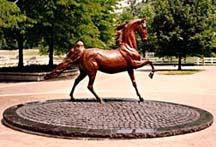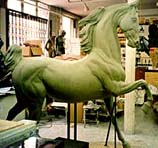A
Champion in the Making

Photo by Mike Davis
⌐
The Creation of the Phoenix Bronze
Part
I
 Patricia begins each life-size portrait bronze
with an in-depth study of the individual subject's
particular anatomy, proportion, way of moving and
individual personality. Once a pose has been selected a
weight-bearing armature is engineered and constructed. Patricia begins each life-size portrait bronze
with an in-depth study of the individual subject's
particular anatomy, proportion, way of moving and
individual personality. Once a pose has been selected a
weight-bearing armature is engineered and constructed.
 After many
months of labor the armature is not only totally covered
and hidden by the sculpted clay, the completed soft clay
also becomes a successful portrait of The Phoenix. This
fragile clay is the original sculpture and stands eight
feet tall. After many
months of labor the armature is not only totally covered
and hidden by the sculpted clay, the completed soft clay
also becomes a successful portrait of The Phoenix. This
fragile clay is the original sculpture and stands eight
feet tall.
Now that the clay sculpture is
completed, the first in a series  of three molds is begun. This first mold is
called a "waste mold". The life-size clay horse
is divided into sections and a mixture of plaster is
slowly built up several inches thick and covers each
section. A framework of pipe is embedded into the plaster
for strength. Once the plaster has hardened, each section
of plaster mold is pulled away from the clay. During this
separation the clay horse, being soft, becomes damaged
goods! But the inside of the hard plaster bears a perfect
impression of the clay horse. of three molds is begun. This first mold is
called a "waste mold". The life-size clay horse
is divided into sections and a mixture of plaster is
slowly built up several inches thick and covers each
section. A framework of pipe is embedded into the plaster
for strength. Once the plaster has hardened, each section
of plaster mold is pulled away from the clay. During this
separation the clay horse, being soft, becomes damaged
goods! But the inside of the hard plaster bears a perfect
impression of the clay horse.
 The sections of waste mold are placed back
together and liquid plaster is poured into the hard
plaster waste mold. When the interior plaster hardens it
is of course in the shape of the horse. To reach the
plaster horse inside however, the exterior plaster mold
must be "wasted" by chipping it carefully away
until it no longer exists. The sections of waste mold are placed back
together and liquid plaster is poured into the hard
plaster waste mold. When the interior plaster hardens it
is of course in the shape of the horse. To reach the
plaster horse inside however, the exterior plaster mold
must be "wasted" by chipping it carefully away
until it no longer exists.
We began with an eight foot soft clay
horse and through use of the waste mold we now have a
hard plaster horse in separate sections: the head and neck, the torso in two halves, four
legs and one tail. head and neck, the torso in two halves, four
legs and one tail.
A latex and rubber mold is now made of
each plaster horse section. The above image shows the
rubber mold of the horse's head (upside down with the
nose pointed at the viewer). The rubber mold is red and
is kept from being able to move or sag by a plaster outer
layer. The plaster outer layer, or "mother
mold" is clamped tightly shut while hot liquid, red
colored wax is poured inside.
Continue to A Champion in the
Making: Part II
|